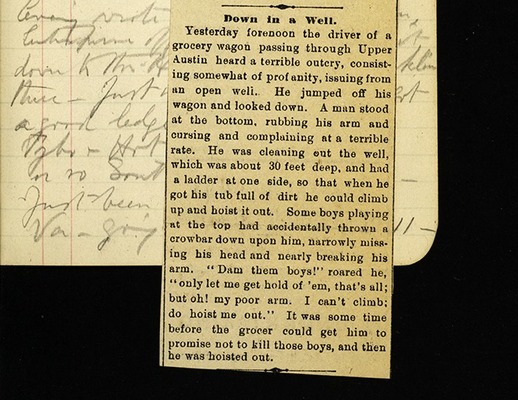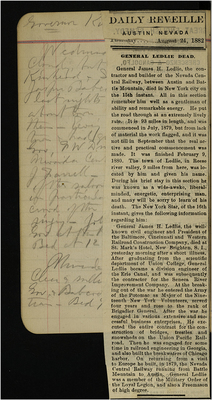Pages
6
[DAILY REVEILLE]
AUSTIN, NEVADA:
Tuesday . . . . . . . . . . July 18, 1882
Austin and Denver.
At the office of the Manhattan Mining Company in this city is a magnificent specimen of the small but exceedingly rich veins of silver ore peculiar to this locality. It is intended to be forwarded to the grand Exposition at Denver, Colorado, which commences on the 1st of next month. It is from the Curtis vein, and when reduced to suitable size and properly dressed, will be about a foot square, weighing 30 or 40 pounds. It shows the full width of the vein, about six inches, and is composed of ruby or antimonial silver, sulphurets, etc., the blending of colors being very beautiful. It also shows the enclosing walls of granite on each side, from which the vein makes toward the center, meeting in a seam of fine, rich crystallized formation. No finer or more interesting specimen will be sent from the Pacific coast.
7
Down in a Well
Yesterday forenoon the driver of a grocery wagon passing through Upper Austin heard a terrible outcry, consisting somewhat of profanity, issuing from an open well. He jumped off his wagon and looked down. A man stood at the bottom, rubbing his arm and cursing and complaining at a terrible rate. He was cleaning out the well, which was about 30 feet deep, and had a ladder at one side, so that when he got his tub full of dirt he could climb up and hoist it out. Some boys playing at the top had accidentally thrown a crowbar down upon him, narrowly missing his head and nearly breaking his arm. "Dam them boys!" roared he, "only let me get hold of 'em, that's all; but oh! my poor arm. I can't climb; do hoist me out." It was some time before the grocer could get him to promise not to kill those boys, and then he was hoisted out.
8
DAILY REVEILLE
AUSTIN, NEVADA
Saturday . . . . . . . August 19, 1882
TERRIBLE ACCIDENT.
The Austin Street Locomotive Wrecked This Morning – Andy Wright, Engineer, Killed and Frank Duffy, Fireman, Severely Injured – Details of the Calamity.
Shortly before six o'clock this morning a terrible accident happened upon the railroad which runs from the Clifton depot of the Nevada Central Railroad up the grade, following Main street to the upper end of the city, whereby the locomotive engineer was instantly killed, and the fireman severely injured. The "Mules' Relief," the dummy locomotive which runs over the road, transporting wood, lumber and general merchandise from the lower depot up the grade to the Main street depot of the railroad, and to the Manhattan mill, has been doing that work nights for several weeks past, on account of repairs to the track being made during the day. The grade down Main street and to the depot below town, is very steep, about one foot in eight, and the locomotive was made especially for it. It was a powerful, well built machine, weighing 33,000 pounds, and has been in use only about a year.
THE ACCIDENT.
Some trouble was experienced with the brake last evening, necessitating a stoppage for repairs, and subsequently during the night the brake gave occasional trouble, but not sufficient to induce further stoppage. At the time of the accident this morning, the engineer, Andy Wright, and Frank Duffy, the fireman, were the only persons on the locomotive. Mr. Duffy says that just below the reveille office, where the grade has a little sharper pitch than elsewhere, the brake commenced acting defectively, and directly the locomotive was going at a dangerous rate of speed. The wheels kept slipping in spite of all efforts to the contrary, and they went whirling down pat the Citizens' mill to the curves below, at a fearful rate of speed. The locomotive was going with rear end foremost, and both men were at that end, Wright at the throttle and Duffy at the brake. Duffy says the last he can remember was that Andy told him to "Kick the brake," in order to give the wheels a possible chance for a fresh hold, and the next instant in whirling around a sharp curve a short distance below the Citizens' mill and nearly opposite Horton's powder house, he was thrown violently out, falling heavily upon his right side in the road.
THE WRECK.
As soon as he could retain his senses sufficiently, Duffy arose to his feet and saw the locomotive lying over on its side by the track, some twenty or thirty yards below him, with the wreck of the wood work scattered along for several yards. The steam was blowing off, and no one was in sight. His face and throat were bleeding profusely, and his right shoulder seemed broken. He staggered up the road a short distance and met a man, who took in the whole situation at a glance and ran up town for assistance, while Duffy managed to make his way to the residence of Gus Bauer near by, where he was at once properly cared for. In a very few minutes parties were at the scene of the wreck, and found Andy Wright lying beneath the engine dead. They got picks, shovels, etc., and soon had the body out. Andy had evidently stood at his post, until the machine went over, catching him beneath its ponderous weight, and then grinding its entire length over him. His remains were very broken up, and as soon as practicable, were taken charge of by the undertaker.
THE DECEASED
Was about 40 years of age, a native of Philadelphia, and leaves a wife and three daughters, the youngest an infant about two months old, residing at Rocklin, Place county, California. Andy Wright was a very worthy man, standing high in the estimation of all who knew him. He was a member of the Sacramento Division of the Brotherhood of Engineers, and a most excellent mechanic. He had been employed upon this road about a year, running the locomotive almost from the first of its being placed on the track.
DUFFY'S INJURIES.
Mr. Duffy was pretty badly shaken up by his fall, and could not for an hour or two realize the full extent of his injuries, or the final particulars of the accident. His shoulder is badly strained, but not broken, he has a severe flesh wound on his left leg, below the knee, requiring several surgical stitches, and his whole right side is more or less bruised. His face is also considerably lacerated and bruised on the right side, and his throat received quite a gash, disagreeably near the jugular vein, but fortunately not deep enough to do serious damage. He was lucky in not being killed outright. About 8 o'clock this morning he was removed to the residence of W. H. Clark.
CLEARING UP.
After the locomotive went over on its side it was carried forward by its own fearful impetus some twenty yards or more, stripping the wood work housing with which it was enclosed completely off, and leaving it a dismantled wreck. Had it gone on a few yards further, it would have rolled over the steep bank down into the canyon. As it was, just room enough was left for teams to pass. As soon as possible a force of men were put to work clearing away the wreck, and carrying it up to the machine shops of the Manhattan mill.
9
DAILY REVEILLE
AUSTIN, NEVADA
Thursday . . . . . . . August 24, 1882
GENERAL LEDLIE DEAD
General James H. Ledlie, the contractor and builder of the Nevada Central Railway, between Austin and Battle Mountain, died in New York city on the 15th instant. All in this section remember him well as a gentleman of ability and remarkable energy. He put the road through at an extremely lively rate. It is 93 miles in length, and was commenced in July, 1879, but from lack of material the work flagged, and it was now till in September that the real active and practical commencement was made. It was finished February 9, 1880. The town of Ledlie, in Reese river valley, 9 miles from here, was located by him and given his name. During his brief stay in this section he was known as a wide-awake, liberal-minded, energetic, enterprising man, and many will be sorry to learn of his death. The New York Star, of the 16th instant, gives the following information regarding him:
General James H. Ledlie, the well-known civil engineer and President of the Baltimore, Cincinnati and Western Railroad Construction Company, died at St. Mark's Hotel, New Brighton, S[taten]. I[sland]. yesterday morning after a short illness. After graduating from the scientific department of Union College, General Ledlie became a division engineer of the Erie Canal, and was subsequently the contractor for the Seneca River Improvement Company. At the breaking out of the war he entered the Army of the Potomac as Major of the Nineteenth New York Volunteer, served four years and rose to the rank of Brigadier General. After the war he engaged in various extensive and successful business enterprises. He executed the entire contract for the construction of bridges, trestles and snowsheds on the Union Pacific Railroad. Then he was engaged for some time in railroad engineering in Georgia, and also built the breakwaters of Chicago harbor. On returning from a visit to Europe he built, in 1879, the Nevada Central Railway running from Battle Mountain to Austin. General Ledlie was a member of the Military Order of the Loyal Legion, and also a Freemason of high degree.
10
A REPRESENTATIVE PICTURE.
Commissioner George, at Denver, expressed an urgent desire for some sort of a picture representing the underground workings of the Comstock, the greatest and heretofore most important silver or gold mine on the American continent, in order to give the people of the East some idea of the way mining is conducted in Nevada. Such a picture as it happened, was more easily found than at first supposed, through the courtesy of J. Minor Taylor, Secretary of the Bonanza firm at Virginia, one was obtained and forwarded on Monday last. It is a lithograph copy of the famous sketch, by Thomas L. Dawes, formerly a young English miner residing in Gold Hill, who died in Nevada county, California, about a year ago.
The picture is entitled "Mining on the Comstock." It is about three feet square, and represents a section of the Belcher mine, Gold Hill, in its bonanza days, showing how a very large ore body is worked the regulation mode of timbering, the shaft with its various compartments, pumps, cages, etc., the incline from the bottom of the shaft, following the dip of the vein, the "giraffe" and other peculiarities of the incline, the system of winzes, tunnels, drifts, crosscuts, ore breasts, stopes and all that sort of thing. The men are also seen at work with all the most approved styles of tools, Burleigh drills, underground engines driven by compressed air, going on or off shift, and even the style of dress or working undress of the miners is accurately given. The numerous barrels of ice-water, cooling rooms and other arrangements and conveniences about a hot mine are also shown, and nothing is lacking to make the picture correct in all its details. The huge hoisting works at the surface are also neatly drawn, and several sketches connected with the surface appliances of the Comstock are shown. It is the best picture ever drawn of the subject it represents, and is well worthy of a prominent place in Nevada's part of the great Exposition,






